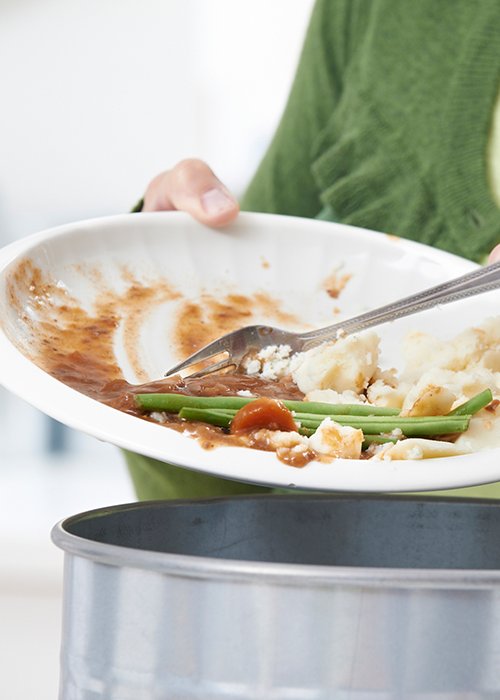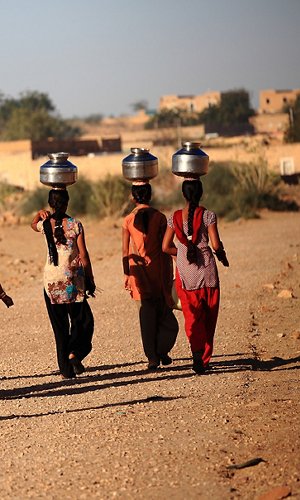How often have we opened the refrigerator to find a couple of eggs and a yoghurt expired a few days ago, a bit of wilted salad, half a bottle of a fizzy drink or a carton of milk open for too many days… at least so the packaging says. Moving to the cupboards we find a pack of Chinese noodles bought years ago after attending a course on oriental cooking, a bag of expired flour, bought when we thought of replacing packed snacks with a home-made cake, and a few potatoes with sprouts now ready for planting. What becomes of this food, which we now consider inedible? The rubbish bin, of course! Along with the food we throw away at home we must then add the leftovers that we leave at the restaurant, at the bar, in the canteen and so on. All this translates into food waste: every year, each European citizen throws about 95 kg of food into the rubbish bin! Let’s see in detail how, how much and where food is wasted and try to understand how we can reduce food waste.
Voice search

Praising the meatball
What is food waste
When we speak of food waste, we must distinguish between food losses and food waste. By food loss is meant the loss or weight or nutritional quality of food originally intended for human consumption, usually caused by supply chain inefficiencies. When, on the other hand, food is discarded at the point of sale and of final consumption we speak of food waste1. Whatever name we use to speak about food that ends up in the rubbish bin, we ought to know that this food has consumed energy, land, water, fuel, natural resources, human labour and money to be produced, transported, processed, packaged, stored, sold, purchased, transported again and stored at home. Moreover, food production also has an impact on the environment as it involves CO2 emissions into the atmosphere, contributing to climate change, and the introduction of pollutants into various environmental sectors, such as fertilizers, which pollute the ground and water. And that’s not all! Wasted food, in fact, becomes waste, requiring more resources to be managed and disposed of.
1 FAO. 2011. Global food losses and food waste – Extent, causes and prevention.
Waste figures
Every year about one third of all the food that is produced in the world is wasted, that means 1.3 billion tonnes of food which, instead of ending up where it should, i.e. on our plates, is thrown into the rubbish bin. The inhabitants of North America and Oceania are those who waste the most food (approx. 300 kg/year), immediately followed by Europeans (280 kg/year). How much food do Americans and Europeans initially have available before wasting it? Americans have on average 900 kg of food per year: of this, 600 kg will be eaten and 115 kg wasted, buying it to then throw it in the rubbish bin. And the remaining 185 kg? That is lost along the way, in the long supply chain that goes from the producer to distribution, without even realising the extent of the waste. The same goes for the inhabitants of Europe who have access to 840 kg of food per year, of which only 560 kg is eaten, while 95 kg ends up in the rubbish bin after purchase and the remaining 185 kg is lost along the supply chain. In Africa and South East Asia, the food available per capita is much less, approx. 460 kg per year: nevertheless, 120 and 170 kg per capita per year, respectively, disappears into the rubbish bin. Of this, 6 and 11 kg, respectively, is wasted by the end user, while the remainder is lost along the supply chain. The percentage of food waste remains high even in countries in the developing world, with the difference that in these countries, waste is concentrated along the supply chain, not at the time of consumption, which is the case in industrialised countries. In industrialised countries, in fact, there is waste because too much food is produced and bought, which is often thrown away even before it deteriorates. In developing countries, on the other hand, food is wasted due to lack of infrastructure, systems for food preservation and adequate means of transport.
From field to fork: the waste chain
Where do we begin to waste? From the very beginning! Waste, in fact, begins in the field, from the initial stages of the food chain. Often food is not harvested or fails to arrive on our tables. Why? The reasons are manifold. Certainly climatic and environmental factors, the spread of diseases and parasites are one of the causes of food losses in this initial part of the supply chain. In order to continue to analyse the causes of losses, we must first make a distinction between industrialised and developing countries, where the different soil preparation, planting and farming techniques generate completely different yields, which are the leading cause of losses.
In developing countries, food losses are attributable to often inefficient farming: the farmer faces an intense amount of work in the field and produces low yields because the technical expertise and financial resources are lacking, harvesting techniques are often inefficient and backward, the available infrastructures are often inadequate and the scarce availability of transport makes it difficult to move the food around. Moreover, the lack of adequate food crop storage and preservation facilities leads to deterioration of the food or attack by insects.
In countries with higher incomes, on the other hand, better technology, more efficient infrastructures, more advanced agronomy skills and farming techniques, as well as often more favourable environmental conditions, lead to a much lower level of losses. Despite this, farmers often leave in the field, or decide to use as animal fodder, crops originally intended for human consumption. Why? There are several reasons:
- supply exceeds demand;
- quality standards for human consumption, imposed by national and international legislation or defined by distributors (normally by large-scale distribution) are not complied with
- aesthetic requirements regarding the shape and size of agricultural products requested by customers are not met. It is assumed that no one will ever buy an apple spotted by a hailstorm or a gnarled eggplant; the products, therefore, remain in the field, since they would nevertheless be discarded in the subsequent stages of the supply chain.
- the invasion of the market by low quality products sold at low prices competes with other products, which must then align themselves with a price that will not repay the production costs. As a result, fruit and vegetables remain in the fields.
Food industry waste
The second stage of the journey that our food makes before arriving on our tables is industry. Food first passes through the processing and then the packaging industries. Both contribute to food waste, let’s see how.
First of all, there is waste due to the remoteness of the processing industries compared to the places of production: the lengthy transport of food from the fields can lead to deterioration of foodstuffs, which are then discarded before processing. During product processing, there is waste, for example, because the market requires only parts of food, for example fish fillets or chicken breasts and legs. In developing countries (but partly also in industrialised countries) the technological equipment is often insufficient and not always able to ensure the correct preservation of food products, especially as regards fresh foods.
Finally, errors in food processing procedures cause defects in terms of product weight, shape or packaging. While these defects do not affect the safety or nutritional value of the products, they are nevertheless discarded.
During the packaging phase, damage to the pack, for whatever reason, almost always involves discarding the entire product, especially when it comes to juices, jams, yoghurts and various preserves. In addition, all those products that do not meet the aesthetic standards required by the market are also discarded. Finally, at the end of the production cycle, products are subjected to quality control: if they fail the test, they become waste.
Waste in the distribution and sales cycle
Transportation, distribution and storage are certainly not exempt from waste. In this phase, there is waste due to inappropriate orders and incorrect food demand forecasts: these are, in fact, very complex operations, affected by many factors, such as climate, seasonality, launch of new products, promotions and festivities. The result is the accumulation of products on the shelves, where they then expire or undergo natural decay (mainly in the case of fruit and vegetables).
In addition there are:
- limitations of the technology used for product preservation, in particular fresh produce;
- damage to products and packaging during transport and storage, making them unfit for sale;
- poor training of sales staff, who sometimes do not display the goods in an adequate manner on the shelves and do not follow the proper stock rotation procedures;
- withdrawal campaigns of certain products from the market, following verification of absence of compliance with certain quality and safety levels;
- sales standards, which exclude from distribution products that do not meet the aesthetic requirements or which have packaging defects;
In addition, certain marketing strategies, such as “two for the price of one” or “three for the price of two” options, which have the purpose of selling products close to expiry or of reducing warehouse stocks, simply transfer the problem, since waste passes from distribution to the end user.
The above arguments for this phase of the process hold true for industrialised countries. In developing countries, in fact, wholesale distribution is absent or nevertheless often inefficient. Waste, therefore, is to be attributed to the characteristics of the markets: small, crowded, with poor hygiene and ineffective food cooling and storage equipment.
Wastage during domestic consumption and catering
And when the food has arrived in our homes, the waste continues. Why? The causes of domestic food waste are many and are linked to:
- lack of purchasing planning, which sometimes leads to buying excessive quantities of food to take advantage of promotional offers;
- lack of product knowledge; for example, the consumer buys food that he then does not know how to prepare or does not know how to create dishes with leftovers or the ingredients available;
- inadequate product preservation, which leads to deterioration ahead of time;
- confusion with regard to labelling information concerning product expiry dates. In fact, there is a big difference between the wording “best before” (referring to the quality of the food) and “use by” (referring to food safety): the presence or absence of the word “best” changes things and in a significant manner. If it is there it means that after that date the food is still edible and by eating it there is no risk of a stomach ache. Certainly, it may have lost taste, aroma, colour, texture and the nutritional values may be decreased, but the food remains safe.
- lack of awareness of the scale of waste that everyone produces and of its economic and environmental impact.
As for waste generated in the catering sector (such as hotels, restaurants, canteens, etc.), the causes of waste are more or less the same, but have even more significant effects:
- the excessive size of the portions of food served which in part is left on the plate;
- the difficultly in planning food purchases, which is further complicated in the case of buffet service (which usually involves the preparation of a greater quantity of food than necessary);
- the uncommon practice of customers taking home the “leftovers” of their meal.
And it doesn’t end there: the impact of food waste on the environment
The huge amount of food produced, not consumed and thrown in the rubbish bin has a significant impact on the environment around us.In fact, when we throw a tub of expired yoghurt in the rubbish bin, not only do we waste food and money, but also valuable resources, such as soil and water. As mentioned earlier in this special, food has required energy, land, water and natural resources to be produced. Although the significant consequences of food waste are recognised, no study has yet analysed and precisely quantified the impact of food waste from the environmental point of view.
According to FAO, the carbon footprint (climate-altering gas emissions) of food produced and not consumed is estimated at 3.3 gigatonnes of CO2:food waste thus becomes the third largest source of emissions in the world, after the United States and China.Apart from CO2, huge amounts of water are needed to produce the food we eat every day. It is estimated that the global water footprint is equal to 250 km3, three times the volume of Lake Geneva. As for the soil, food waste consumes land amounting to 1.4 billion hectares, or nearly 30% of the area covered by farmland in the world.
Foster good habits
So what can we do? Let us remember that, before being consumers, we are citizens and with our choices we can change the trends. We can try to reduce our waste by changing our lifestyle, paying more attention to our daily actions, also when we shop. It is about changing the way we buy food… but how can we do it? Here is some advice:
- Before going shopping, make a list of what is actually needed and buy only that! Don’t be attracted by offers at unbeatable prices and three for the price of two products… if we buy more with the idea of saving but then end up throwing away most of it, we will, in fact, end up having spent more. By limiting our purchases to what we really need, we will be able to keep the products in the refrigerator under control, thus reducing our waste.
- Prefer local producers and sustainable and small scale farming. A farmer who sells directly to the consumer, in fact, does not throw products away just because they do not meet the aesthetic standards of the market. Moreover, those who produce in a sustainable manner and on a small scale use fewer resources (water, fertiliser, etc.) and produce only what they will be able to sell. They do not waste and, consequently, neither do we consumers who decide to buy their products! An example are the Mercati della Terra.
- Buy more ingredients and fewer convenience, processed and elaborated foods. In this way, in addition to knowing exactly what we eat, we will help reduce the waste of the food industry.
- Learn to cook with what we consider leftovers. All cuisines of the world envisage anti-waste recipes, just think of meatballs, Spanish omelettes, flans, etc., which turn kitchen “leftovers” into tasty dishes.
- Put all food in the right place in the refrigerator: fruit and vegetables in the drawers, fish and raw meat on the first shelf; cooked meat on the second; sliced meats and cheeses higher up; open preserves and eggs even higher. This helps food last longer.
- Freeze leftovers, writing the date on the container. Remember, also, that food which is defrosted and then cooked can be refrozen.
- Before throwing something away, open it, smell it, taste it and then decide if it is really the case not to eat it.
To reduce waste it is also necessary to promote interventions of education and information aimed at consumers, with particular reference to food culture, food preparation and the correct methods for food preservation.
Anti-waste initiatives
Food sharing, awareness campaigns, cooking with leftovers courses. Initiatives against food waste are springing up everywhere, involving governments, associations and businesses, from large-scale distribution to the individual bar or restaurant to avoid food waste: here are some ideas already put in place around the world to inspire us, eat better and avoid waste.
Last Minute Market
Last Minute Market (LMM) is a spin-off of the University of Bologna, founded in 1998 as a research activity and, since 2003, a business initiative present throughout the country, with projects aimed at recovering unsold (or unmarketable) goods for charities.
I Food Shares
I Food Share, an online platform that allows the sharing of surplus food, have been operating for some time now in Italy. Anyone can donate food products and share them in order to avoid waste. Citizens, supermarkets, small shops, bakeries and farms can all participate.
Inglorious Fruit and Vegetables
Last year, Intermarché, the large French supermarket chain, set up The Inglorious Fruit and Vegetables campaign with the objective of saving fruit and vegetables that do not match the now overwhelming purchasing criteria of “beautiful = good” from the rubbish bin.
These are just some of the initiatives to reduce food waste. Look for the one that suits you and start to reduce your waste!
Sources
- FAO 2019 – The state of food and agriculture
- FAO 2011. Global food losses and food waste – Extent, causes and prevention.
- WWF – One planet food
- Slow Food. Il nostro spreco quotidiano.
- Barilla Center for Food and Nutrition. Lo spreco alimentare: cause, impatti e proposte.



